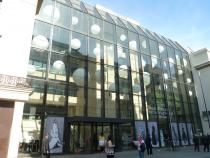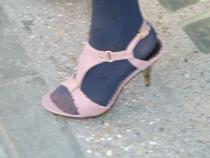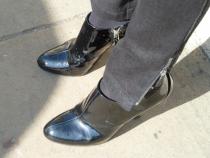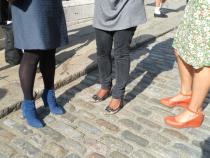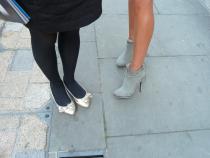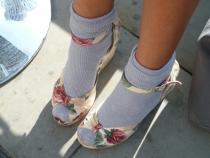The shoes of London Fashion Week 2010
Posted in 2010-2019, 21st Century, contemporary, Diary, Editorial blog posts, galleries, Memory, people, Places, public squares, Retail, shops, Strandlines and tagged with Designer, London Fashion Week, MiuMiu, Shoes, Somerset House, Strand Fashion Week
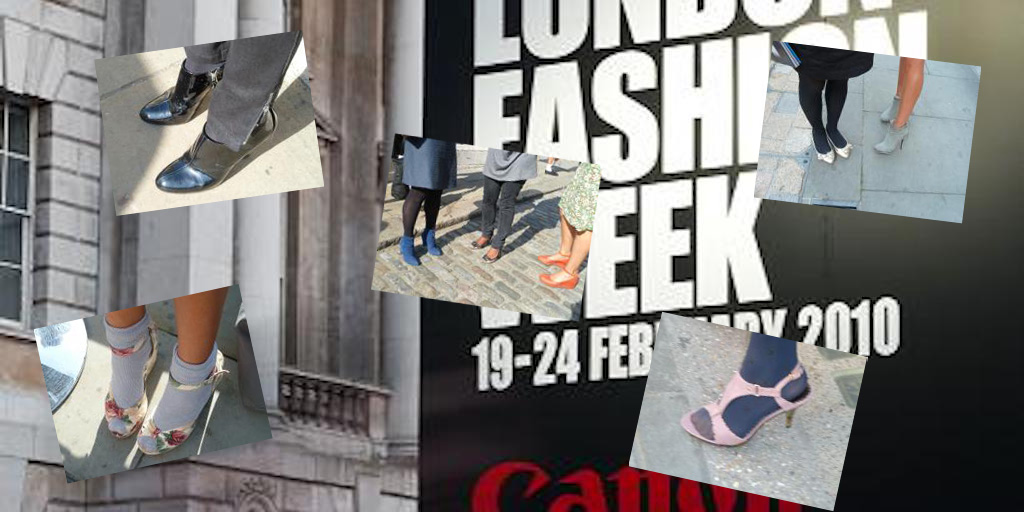
On the Strand this week the big glass window of Coutts the bankers has been hung with large white balls. Glamorous fashion photographs adorn its window and the window of Topshop. It’s been London Fashion Week – or five days, a size zero version of a week – and beautiful creatures have been drifting down the Strand and in and out of Somerset House. As one of my colleagues put it, “when you pass a six foot guy in a mini skirt you know it’s London Fashion Week”.
I passed several astonishing beings yesterday, and thought I would investigate further. One of the differences between the past and present is that in old photographs of street life up until maybe the 1960s, almost everyone wears a hat. Headgear defined occupation and era.
What about shoes? They’ve changed just as much as hats; have our views about shoes changed too? Looking at shoes as their owners passed by me on the Strand, it seemed that on an ordinary day there were consistent types of footwear on show. Shiny shoes, mostly men’s. Trainers and sneakers, both sexes. Flat court shoes, women’s. Fancier shoes, maybe with heels. Boots, more women’s than men’s. It’s obvious from that description I don’t know much about shoes. It mystifies me that the media so often assume women lust after shoes, that Sex & The City gives shoes so much sex. Still, shoes are eloquent about their wearers, and so I started looking at shoes.
All sorts of shoes stopped and talked to me. Thank you to everyone who very kindly agreed to answer a few shoe-related questions!
The first pair I met had brightly coloured undersides and demure pink upper; they were on their way to the shows at London Fashion Week. The second pair came from Miu Miu and were much loved, said their owner. She wore them so elegantly it made me realise shoes could be worn beautifully.
This colourful threesome belonged to three friends who insisted they were not fashionable types but, in their good-humoured phrase, “mummies and drudges”, here for the day because they’d been given tickets.
Leopard print boots belonged to a male model from Sasketchewan in Canada: he said they were by Jeremy Scott for adidas. Jeremy Scott was a New York designer, he added patiently. The grey ankle boots were a bit dirty, said their wearer apologetically, but they were so comfortable ‘I live in them’, she said, ‘I wear them all the time’.
High-heeled ankle boots were plentiful in the Somerset House courtyard; these were among the most chic. I liked their grey softness against the grey pavement. They were with a friend, also a fashion buyer, and she too said her shoes – by John Rocha – were really comfortable. It was the first time either of them had come to London Fashion Week, and they’d come to see what was being bought.
Cream bows belonged to a dedicated follower of fashion, whom I suspected was Very Important but I didn’t have the nerve to ask exactly how. She had the look of someone who had been a size zero for decades and had always been immaculate. What were these clearly exquisite shoes? Prada new season, she said crisply. And why had she bought them? You need a new key piece for the season, she said – “though with bows you have to be careful in case you look like the Queen Mother, you know….”
This floral pair adorned a student of fashion journalism sitting in the sun with a fellow student, their friendship warm as the sun. And her wedges? From Topshop in a sale, bought for this summer but, she said – “you can wear them with socks for autumn”, and her friend in black agreed.
The final pair I found indoors, on a volunteer helper. ‘They’re by Kurt Geiger’, she said, ‘and I like them so much I bought them in two colours.’ The artistry of them made me think I should go and look at the designer shoes in the exhibition. So I blagged a pass and wandered about until I found a shoe designer stall among the jewellers, bag makers and milliners in a sunny part of a building where I’m more used to seeing fine art.
This was fine art, of a kind – even a scruff like me could see the artistry and skill in beading, stitching, draping, feathering. The smell of new leather drew me to the shoes, where alarmingly high heels and flat pumps with crystals looked oddly familiar because outside the dominant shoe types were also teeteringly high ankle boots and flat pumps. Still, up close at eye level there were more marvels – you could see how the crystals were applied by hand, and the soles hand-stitched, and the leather had been made as supple as silk.
I asked a vulgar question: how much do these cost? The very well-groomed rep barely blinked. Her designer had a fine pedigree and these were masterly skills. So, prices started around £300 – that pair – gesturing to a high wedge, on which I could only imagine myself falling over at once, those were £775. They were very comfortable, she assured me, because although they were high, they were perfectly balanced.
I began to feel as bit headachy from the combination of understatement and overstatement, so I left the beautiful creatures drifting in and out of their shows, and returned to King’s. How much shoes express about people! How curious that wildly different shoe designs should nonetheless be pronounced ‘comfortable’, and how curious too that such notions of ‘comfort’ are stiffly fashionable, with not a bedroom slipper in sight!
By Clare Brant ~ wearing Mephisto black nubuck boots – as usual, because they have a grip on the world like tractor treads, and yes, because they are comfortable.
Coda to London Fashion Week
On one of the days that fashion lovelies were parading in Somerset House, I was walking along the Strand where I found myself alongside a crocodile of school children. They were out for a class, dressed in yellow fluorescent jackets over their school uniforms. Besides them was a policeman, also in uniform. The composition was amusing – those who must wear uniforms, big and small, in contrast to the wild self-expression of the carnival of fashion up the road. I asked the accompanying teacher if I might take a photograph…? No, she said – the children can’t give their consent. Ah – of course. I understood, though the recital of regulations came over as automatic to the point of inhuman. Well, such is our world. It does show that visual representations of the Strand can’t catch everything, and that words can do some things pictures can’t, even in this hypervisual age.

